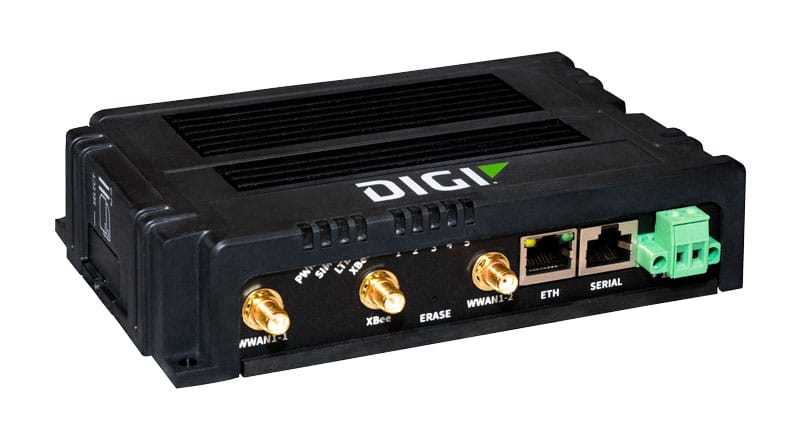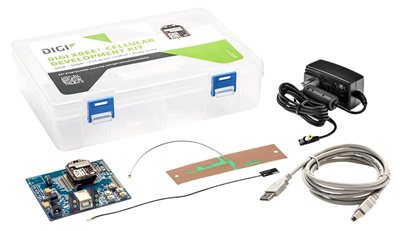物联网 (IoT) 项目可能很复杂,因为需要做出许多决定。对于任何IoT 项目,您都需要购买无线电和网关等通信设备,使用一种或多种连接方法和协议连接这些设备,并确保设备按要求运行。在此过程中还需要做出许多决定,包括电路板设计、天线位置以及与其他设备的互连。IoT 架构就是这些决策的最终结果。
典型的IoT 架构是无线设备、智能网关、路由器和云计算的组合。在本博客中,我们将重点介绍在制定战略时需要选择的无线协议和连接方式,并将介绍相关的物理组件。
评估IoT 架构要求
 为新项目选择最佳的IoT 架构涉及对连接需求的评估,以及对可用技术的评估,当然还有将其整合在一起的资源。对于您需要做出的许多决定,并不存在错误或正确的答案,而是需要评估和选择最适合您的使用案例和所需产品设计功能的方案。
为新项目选择最佳的IoT 架构涉及对连接需求的评估,以及对可用技术的评估,当然还有将其整合在一起的资源。对于您需要做出的许多决定,并不存在错误或正确的答案,而是需要评估和选择最适合您的使用案例和所需产品设计功能的方案。
例如,有几种无线协议可用于设备之间的通信,但它们各自都有特定的优点和理想的使用情况。哪种协议最适合您的部署,取决于您的具体情况。因此,充分了解您的项目和可用选项非常重要。
在 Digi,当我们与客户合作帮助确定他们的IoT 架构需求时,我们会提出许多问题并审查一系列选项。以下是一些高层次的重要考虑因素,可帮助您有条不紊地开展工作:
- IoT 架构功能:
- 您的IoT 架构是否需要收集数据,例如在传感器网络中?
- 是否需要包括监测和控制,如 SCADA 网络?
- 您的设备需要多频繁地发送数据?
- 设备和网关之间的距离是多少?
- 从终端节点向网关发送数据的速度有多快?
- 您是否有必须满足的严格时间要求?
- IoT 设备将如何连接到云端?
- 例如,在大型或远程网络中,如果需要频繁更换电池,成本会很高或效率会很低?
- IoT 设备选择:上市时间和"建造与购买"的考虑:
- 您需要选择IoT 设备,如支持项目所需功能的无线电和网关。
- 如果时间并不重要,您可以从头开始构建解决方案。
- 如果上市时间是关键所在,那么最好从预制和预认证的无线模块开始,并有可能参与支持服务。
- 管理已部署的设备
- 确定是否需要支持无线 (OTA) 选项的协议,以便更新所有设备上的固件。
- 如果没有,请确定您是否有能力使用更新的协议,因为这种协议很可能会有固件升级来修复问题或增强功能。
- 在没有 OTA 固件升级的情况下,必须考虑到在现场进行逐一升级或发送 "卡车卷 "以更新设备的成本。
所有这些决定都将影响项目的整体规划、部署和管理,并最终影响总体拥有成本。让我们来详细了解其中的一些考虑因素。
拓扑和边缘计算注意事项
在准备设计IoT 网络时,许多工程师都会提出一个关键问题:"什么拓扑结构最适合我的应用?其中一些选项包括 Zigbee 或 DigiMesh 等网状网络协议,以及点对点或点对多点。在某些情况下,根据前面提出的问题,哪种拓扑结构最合理是显而易见的。在其他情况下,则需要额外的研究和测试。
在下面的章节中,我们将介绍在评估哪种拓扑结构最适合您的需求时需要考虑的一些事项。
网状网络
 网络工程师通常都有使用特定拓扑结构的经验,他们可能会认为这种拓扑结构可用于任何环境,但有时另一种选择对于不同的用例来说更为理想。要确定网状网络拓扑结构是否适合您的应用,了解这种策略的利弊非常重要。
网络工程师通常都有使用特定拓扑结构的经验,他们可能会认为这种拓扑结构可用于任何环境,但有时另一种选择对于不同的用例来说更为理想。要确定网状网络拓扑结构是否适合您的应用,了解这种策略的利弊非常重要。
需要分析的一个关键因素是系统的时序要求。网状网络拓扑结构将数据从一个节点路由到另一个节点,整个网络以网状结构构建。因此,需要考虑 "跳转 "带来的延迟。您需要在 100 毫秒内返回数据,还是可以接受一秒一次?
最终还是由您来决定,但拥有不同拓扑结构的选择可以决定无线部署的成败。 您的 Digi 团队可以为您评估这些权衡提供支持。
网状网络的特点:
- 网状网络的优势在于支持网络中的大量节点,在某些情况下可多达上千个,具体取决于网络结构。
- 数据可智能地从节点到节点再到网关。
- 如果一个节点在网络中消失,网络会重新发现一条新的路径,确保数据能顺利到达网关。
- 如果一个节点被添加到网络中,一旦被发现,网络就可以通过添加的节点路由数据。
- 网状网络允许从节点或设备到网关的多条路径,从而提供冗余,并能在条件发生变化时灵活调整。
- 还可以建立子网络来隔离相邻网络的数据。当你拥有一个有成千上万节点的密集网络(如太阳能发电场或智能照明应用)时,如果不考虑延迟问题,这绝对是一个绝佳的功能。
网状网络有Zigbee等标准,也有DigiMesh 等点对点网络,Digi 支持这两种协议。
Zigbee 和 DigiMesh 之间的主要区别:
- Zigbee 通常使用 2.4 GHz 频率,而 DigiMesh 可使用 2.4 GHz XBee 模块以及 900 MHz 和 868 MHz XBee 模块。
- Zigbee 有终端节点、路由器和协调器,分别代表终端设备、中继器和网关。
- DigiMesh 是一种点对点网状网络,它还提供自愈功能、密集网络操作、通过睡眠模式延长电池寿命以及简易设置和配置。
要了解其中的利弊,并确定适合您的使用案例的协议,您可以在我们的相关博文中比较Zigbee 和 DigiMesh的优缺点。 如需更深入的了解,请参阅《Zigbee 与 DigiMesh 白皮书》。
点对点或点对多点
 无线点对点(PTP)和点对多点(PTMP)拓扑结构可用于多种应用中的连接,例如希望用无线通信取代电缆的用例。这些协议可在两台设备之间(点对点)或从一台设备到多台设备(点对多点)进行通信。
无线点对点(PTP)和点对多点(PTMP)拓扑结构可用于多种应用中的连接,例如希望用无线通信取代电缆的用例。这些协议可在两台设备之间(点对点)或从一台设备到多台设备(点对多点)进行通信。
有几个因素需要考虑,如距离、定时和电池电量,这些因素可能表明是否需要 PTP 网络而不是网状网络。
以下是 PTP 和 PTMP 协议的一些要点:
- 如果您需要为一两英里外的几台设备提供无线链路,而且视线良好,那么 PTP 可能是最简单的解决方案。
- PTP 或 PTMP 对于电池供电的应用非常有效。可以在需要时发送数据,然后根据通信需求启用睡眠模式。在 PTP/PTMP 类型的应用中,电池可持续使用数年的情况并非罕见。
- 相比之下,网状网络会增加延迟,而且更耗电,因为需要一个由电源供电的路由器或中继器。
因此,如果您的网络规模较小,且范围明确,PTP/PTMP 比网状网络有很多优势。
PTP 和 PTMP 网络的另一个优点是设置简单快捷。 它们能很好地与 Modbus 等有严格定时要求的协议配合使用。
与手机、Wi-Fi 和蓝牙直接连接
 除了我们讨论过的IoT 架构外,您还可以在必要时通过 Wi-Fi 和蜂窝网络将设备直接连接到云。每种策略各有利弊。
除了我们讨论过的IoT 架构外,您还可以在必要时通过 Wi-Fi 和蜂窝网络将设备直接连接到云。每种策略各有利弊。
Wi-Fi 可能是目前最普遍的协议。不过,重要的是要考虑客户现场的互联网可用性及其安全政策。让您的IoT 设备连接到他人的 Wi-Fi 网络并非一蹴而就。这可能需要额外的安全审查,在某些情况下,根据客户的公司政策是不可能的。
在住宅应用中,要处理数百个不同的无线接入点以及客户对 Wi-Fi 的不同技能水平,也是一项挑战。
蜂窝应用的重要考虑因素
- 使用蜂窝无线电进行连接时,您需要确保能够接入蜂窝网络,这在大多数城市环境中都很常见,但在较偏远的农村地区可能会有困难。
- 您需要考虑数据传输速率,并确保您以应用所需的速度向云发送数据。LTE-M 和 LTE Cat-1协议非常适合大多数从传感器向云端发送数据的IoT 应用。
- 此外,还需要考虑激活、数据计划、SIM 卡管理和远程设备管理等问题,因为在维护IoT 设备的蜂窝连接方面涉及到更多的活动部件。
其中一个例子就是与 Verizon 或 AT&T 这样的运营商合作。 如果您是一家初创公司或刚刚开始第一个蜂窝IoT 项目,直接与 Verizon 或 AT&T 等运营商合作有时可能会令人沮丧。与 MVNO(移动虚拟网络运营商)合作可以提高效率,帮助您及时启动IoT 项目。Digi 还提供计划、SIM 卡和远程管理工具(Digi Remote Manager®),帮助您的项目快速进入市场。
IoT 的另一个趋势是在模块上支持双无线电,如Digi 的 XBee 3 产品。你有一个主要的无线协议,如 LTE-M、Cat-1、Zigbee 或 802.15.4,同时还有一个内置的蓝牙链接,用于配置和管理。
试想一下,当您走到现场的设备前,无需连接电缆即可进行配置或故障排除,只需使用蓝牙链接和手机上的应用程序即可。与随身携带电脑和电缆进行配置相比,这也让调试设备变得轻而易举。
随到随学的交流活动
 无线网络可以采用多种拓扑结构和配置。例如,通过无线链路将远程传感器或设备连接到智能网关,智能网关可选择通过蜂窝网络、Wi-Fi 或以太网回传数据,这种方法是行之有效的。数据从远程设备或传感器收集,然后通过无线链路发送到智能网关。然后,网关将数据 "回传 "到云端进行分析或控制。
无线网络可以采用多种拓扑结构和配置。例如,通过无线链路将远程传感器或设备连接到智能网关,智能网关可选择通过蜂窝网络、Wi-Fi 或以太网回传数据,这种方法是行之有效的。数据从远程设备或传感器收集,然后通过无线链路发送到智能网关。然后,网关将数据 "回传 "到云端进行分析或控制。
插入式网络 "是为您的应用创建一个特定的网络。在 SCADA 或遥测环境中,会引入一个网关,该网关不仅具有回程能力,还能连接远程射频节点来回发送数据。
在某些无须安装的网络应用中,只需将蜂窝路由器连接到设备上即可。例如,零售店的自助终端或 POS 终端使用蜂窝连接来处理交易。
.jpg?lang=en-US) 插入式网络的另一个优势是,你不必依赖或寻求批准加入现有网络。通常,获得加入客户 Wi-Fi 网络的许可要比设计和部署自己的网络花费更多时间。创建插入式网络可以让你灵活地决定网状、点对点和点对多点之间哪种拓扑结构最合适,然后让你能够控制网络的方方面面。
插入式网络的另一个优势是,你不必依赖或寻求批准加入现有网络。通常,获得加入客户 Wi-Fi 网络的许可要比设计和部署自己的网络花费更多时间。创建插入式网络可以让你灵活地决定网状、点对点和点对多点之间哪种拓扑结构最合适,然后让你能够控制网络的方方面面。
由数千个节点组成的网状网络可以频繁地与网关通信,非常适合太阳能发电场和街道照明等应用。在 PTP 或 PTMP 应用中使用具有插入式网络拓扑结构的长距离 900 MHz 无线电,可以帮助您覆盖分布在油田或农业环境等远距离的设备。
基于蜂窝网络的Digi XBee 3 模块还可以绕过传统的网关拓扑结构,直接将数据从设备发送到云端,但这需要为解决方案中实施的每个 Digi XBee® 3 蜂窝调制解调器制定数据计划。幸运的是,随着时间的推移,数据计划的成本已大幅下降,而且运营商正在开发创新的蜂窝数据计划,如集合或分层蜂窝计划。Digi 可以与您合作,帮助您确定适合您应用的最佳解决方案。
边缘智能
 边缘智能是IoT 的最新趋势之一。 边缘计算 在从大量设备向云端发送数据时,"云计算 "有助于提高解决方案的效率并减少延迟。决策和数据处理可以在边缘进行,而不是将所有数据发送到云端进行分析和操作。这样可以减少通过网络的流量,提高性能。
边缘智能是IoT 的最新趋势之一。 边缘计算 在从大量设备向云端发送数据时,"云计算 "有助于提高解决方案的效率并减少延迟。决策和数据处理可以在边缘进行,而不是将所有数据发送到云端进行分析和操作。这样可以减少通过网络的流量,提高性能。
电池寿命也是远程部署传感器的一个关键因素。通过网络传输的数据越多,对电池的消耗就越大。因此,重要的是要考虑清楚需要设备报告的频率,并定制模块连接以获得最佳性能。
边缘智能可帮助远程传感器节点知道何时根据条件变化发送数据,从而减少昂贵的发射电流消耗,在蜂窝网络情况下还可减少数据费用。
Digi XBee 模块上的 MicroPython 允许工程师创建边缘智能,从而优化电池寿命等。例如,如果传感器读数没有变化,边缘设备就不需要发送数据,可以通过保持睡眠模式来节省电池。
边缘计算还允许终端设备做出有条件的决定,而不是向网关查询命令,这就像孩子不断向父母请求允许做某事一样。再进一步类比,如果不想让孩子事事都要父母同意,可以为设备添加一些智能,让它来处理非关键流程。
智能网关
 在许多类型的IoT 应用中,数据会从设备向网关流动。例如,当传感器数据输入并传输到云端时,智能网关,如 Digi XBee 工业门户 可以汇总数据,也可以对特定传感器数据采取行动,这有助于优化与云的通信。
在许多类型的IoT 应用中,数据会从设备向网关流动。例如,当传感器数据输入并传输到云端时,智能网关,如 Digi XBee 工业门户 可以汇总数据,也可以对特定传感器数据采取行动,这有助于优化与云的通信。
这种智能在涉及蜂窝回程(即运营商的数据计划和成本)时尤其有价值。采用 Python 等可编程语言的网关可让用户为网关添加一些智能,从而更有效地管理数据。您可以通过 Python 代码优化您的解决方案,而不是通过默认的回程协议将数据通过网关。这样做可以帮助您避免发送大量数据,减少蜂窝数据费用,并在设置阈值以警告您特定事件时迅速采取行动。
网关中的其他回程通信选项(如 Wi-Fi 和以太网)对于IoT 应用也非常有用。在有本地网络的情况下,可以连接网关以避免蜂窝网络费用。不过,当只有蜂窝网络覆盖时,如果有国内和国际不同运营商的选择,就可以在需要进行全球部署时轻松应对。对于IoT 应用而言,管理已部署网关以进行诊断和故障排除的工具以及远程固件升级功能是必不可少的。
IoT 安全
在评估IoT 架构组件时,安全是IoT 解决方案需要考虑的另一个方面。 虽然数据包加密是大多数嵌入式安全系统的基础,但您是否考虑过安全启动、保护硬件端口、身份验证和安全连接?
每个IoT 设计人员都应考虑其IoT 设备硬件和软件的可用安全措施,并在IoT 项目开始时评估安全技术,以降低风险并确保成功。例如,Digi XBee 模块使用安全会话并集成了Digi Trustfence®安全框架。
原型设计、测试和开发资源
虽然在规划IoT 架构时需要考虑很多问题,但幸运的是,有一些资源可以帮助您。
用于原型开发和测试的开发套件
 IoT 开发套件 是测试功能的关键。一般来说,开发套件成本较低,包含分析不同类型无线网络所需的所有硬件。通过几种不同的开发套件进行测试,以确定哪种套件最适合您的应用,这种情况并不少见。开发套件的另一大优势是,您可以在 Digi-Key 或 Mouser 等分销商处轻松找到它们,订购后一天就可以在实验室进行测试。
IoT 开发套件 是测试功能的关键。一般来说,开发套件成本较低,包含分析不同类型无线网络所需的所有硬件。通过几种不同的开发套件进行测试,以确定哪种套件最适合您的应用,这种情况并不少见。开发套件的另一大优势是,您可以在 Digi-Key 或 Mouser 等分销商处轻松找到它们,订购后一天就可以在实验室进行测试。
IoT 开发工具包使学生、制造商和工程师能够以低廉的价格快速制作出无线IoT 解决方案的原型。
IoT 开发工具
 对于使用Digi XBee 模块设计应用程序的开发人员,Digi 提供了一套屡获殊荣的工具: Digi XBee 工具.该套件包括硬件和软件,旨在帮助团队快速开发、构建、部署和管理IoT 应用程序。
对于使用Digi XBee 模块设计应用程序的开发人员,Digi 提供了一套屡获殊荣的工具: Digi XBee 工具.该套件包括硬件和软件,旨在帮助团队快速开发、构建、部署和管理IoT 应用程序。
Digi 还提供教程和视频,帮助开发人员设计原型并进行测试。请参阅我们的博文、 Digi XBee 开发无线应用程序的教程和资源该网站提供了这些资源的目录。
原型设计和产品开发支持服务
利用专门从事原型设计、测试和IoT 项目其他方面的服务,可以快速加快项目进入设计阶段甚至开发阶段的速度。例如,Digi Wireless Design Services为IoT 项目提供从构思到完整开发和认证服务的全方位支持。
虽然您自己可以做很多事情,但在计划部署的地方进行现场勘查有助于避免实验室中没有预料到的问题。现实世界中的大多数应用都不是在最理想的射频条件下进行的。建筑物、墙壁、树木和其他结构等障碍物很容易干扰无线网络。现场勘测可以帮助您确定哪种天线最合适(或是否需要定制天线)、本底噪声(或潜在的射频干扰源)是什么样的,以及是否有任何您在制定解决方案时没有预料到的 "问题"。
在进行现场勘查的同时,对负责安装的技术人员进行一些培训,这样就能在游戏中领先一步。
其他IoT 架构考虑因素
IoT 解决方案的无线部分还需要考虑其他方面。其中有些问题初看起来似乎微不足道,但如果在IoT 项目的规划阶段没有考虑到这些问题,就可能需要更换电路板或花费更多时间进行固件更新。
以下是其中的一些注意事项:
- 监控设备需要 GPS/GNSS 服务吗?GPS 是否可以与您选择的蜂窝调制解调器一起使用,还是在电路板上安装单独的 GPS 调制解调器更好?(请参阅我们的博文:GeoIoT :快速轻松地将 GPS 定位服务添加到您的IoT 应用程序中)。
- 您是想在北美等一个地区部署,还是要在全球范围内使用您的解决方案? 这对IoT 设备选择所需的产品 SKU 以及所需的认证和相关成本都有影响。(请参阅我们的博文《蜂窝部署走向全球》)。
- 一旦设备部署到现场,您计划如何管理固件升级、远程诊断或故障排除?(请参阅我们的博文:什么是IoT 设备管理?)
- 您的解决方案是否会暴露在高温或低温环境中? 如果是,解决方案的哪些部分会根据温度限制操作?
与合适的合作伙伴和解决方案合作,可以帮助您确保解决方案取得成功,并迅速实现投资回报。Digi 是一家端到端IoT 解决方案提供商,为原型设计、开发和部署提供集成的硬件、软件、工具、安全解决方案和服务。
摘要
成功部署IoT 需要大量的研究、规划、测试,有时还需要咨询和外包。请花时间权衡各种选择,在承诺使用IoT 架构之前,不要害怕测试几个开发套件。在项目开始时花时间研究和了解各种替代方案,可以为您节省时间、金钱和麻烦。
Digi 可以与您合作,确定合适的协议、射频硬件、软件和专业服务。请联系我们,开始对话。